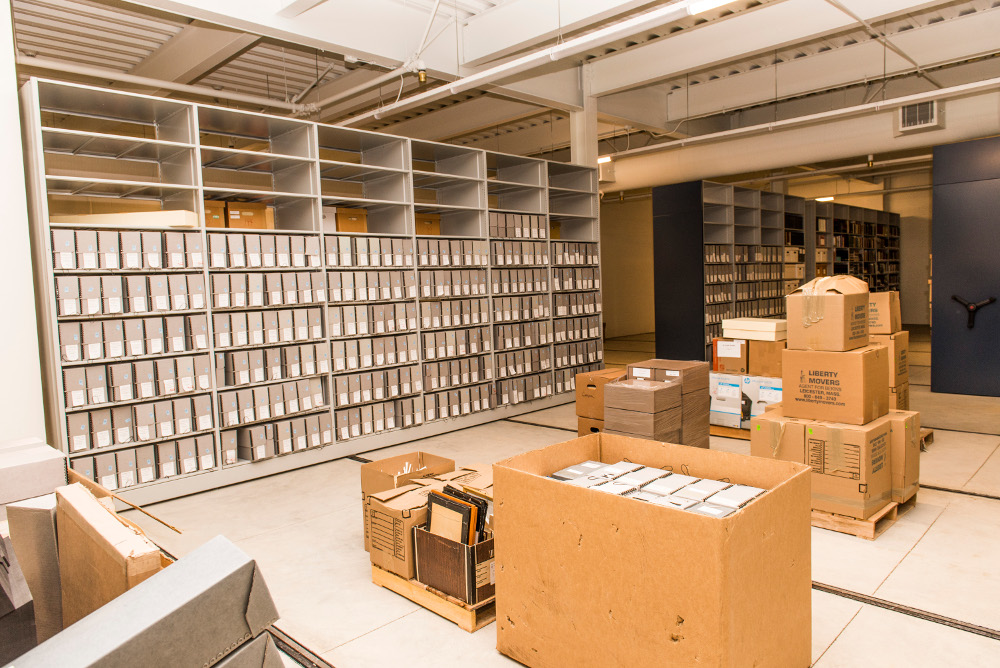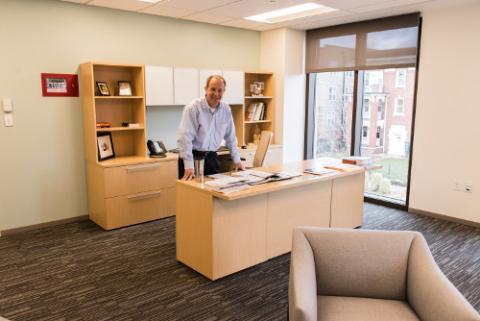
Archive contents ready for unpacking (Jesuit Archives and Research Center)
A new facility is opening in St. Louis to keep the history of one of the Catholic Church's most influential orders in the United States alive and well-preserved.
The Jesuit Archives and Research Center will bring together the collections of several of the order's provinces, providing a valuable resource to historians, archivists and anyone else interested in the history of the Society of Jesus in the U.S.
"Every province of the Society of Jesus has some kind of archive; that's [mandated] in our law," Fr. John Armstrong, the socius, or executive assistant, of the order's U.S. Central and Southern Province, told NCR.
During the mid-1990s, four American provinces brought their collections together to form what was then known as the central archive. "They thought that if they banded together, they could have a much more professional and high-quality facility," Armstrong explained.
The provinces chose St. Louis as the home of their new combined archive, located in what was then the Missouri Province. By 2014, the Jesuits in the U.S. had begun a realignment process, which is set to reduce the number of Jesuit provinces in the United States from 10 to four by 2020. The Missouri Province (along with the New Orleans Province) was superseded by the new Central and Southern Province.
As realignment continued, "many of these other provinces were in the process of dealing with all that they needed to do to form these new provinces. They really were not in a position" to plan for new archives like the one in St. Louis, Armstrong said. The Central and Southern Province decided to expand the archive, and "any other province that wanted to join, we would certainly welcome," he added.

David Miros (Jesuit Archives and Research Center)
The Central and Southern Province will maintain the new center, in partnership with other provinces housing material there, and has the capacity to add collections.
Most of the other American Jesuit provinces are expected to add their collections as they close, making way for the new alignment of provinces.
"The collections close as provinces close," said Jesuit Archives and Research Center director David Miros, "and then they'll come to us here in St. Louis."
The society's New Orleans collection is being added to the archives this spring. The collections of the California and Oregon provinces are expected to arrive from Santa Clara University and Gonzaga University as well.
The new archives will also be able to maintain the growing archives of the new provinces, although "by and large, since they're really brand new provinces, they haven't generated enough records for us to receive those collections," Miros said.
Advertisement
The society has a long history of meticulous record-keeping dating back to its founding. According to John W. O'Malley's 1993 book The First Jesuits, "The letters of [founder] St. Ignatius alone fill 12 volumes … constituting the largest correspondence extant of any sixteenth century figure, none excepted."
"There's a long history of Jesuits' letter-writing, Jesuits' keeping journals and daybooks," said Miros. "So we continue that tradition here in St. Louis by housing those kinds of records."
Jesuits began serving in the Americas almost as soon as the European discovery of the New World. After the order was briefly suppressed in the 18th century, a casualty of shifting late-Enlightenment-period politics, the Jesuits returned to America, where they have been continuously serving ever since the order's restoration in 1815.
The oldest documents currently in the archive come from the Missouri Province's collection, and are church records from St. Charles Borromeo, dating back to the 1780s and 1790s. The parish was given to the care of Jesuit missionaries upon their arrival in the St. Louis area in 1823.
Their "Missouri Mission" would eventually grow into the province, whose history up until the provincial realignment of 2014 is now preserved at the Jesuit Archives and Research Center.
In addition to provincial records, the archives also have the personal records of deceased members of the order, which include some fascinating historical documents. For example, letters of Gen. John Pershing, who led the American Expeditionary Forces during World War I, are included because a Jesuit wrote a biography of him. "The collection is as diverse as the research interests of the individual Jesuits," Miros said.

Crucifix of 19th-century Jesuit missionary Peter DeSmet (Jesuit Archives and Research Center)
Moving the collections to the new facility involved "trucks, pallets, boxes and willing people," according to Miros, adding that good weather also helped the transfer. A local moving company specializing in moving records helped transport the 5,000 boxes of records in around a dozen trucks. The records were barcoded. Some had to be specially wrapped and others were so fragile they had to be delivered to the new site by hand, but the move went smoothly, and was completed over a week.
The 32,000-square-foot research center is about six blocks away from the province's old archive, which was too small at around 4,000 square feet. The new center will provide greater and easier access to its collections, and is fitted with the necessary climate control and fire protection.
It will have space for exhibitions, as well as classroom space, offices, conservation space and digitization space, and has the capability to host conferences and symposiums.
The new center "achieves two goals," Miros said. "One, it increases the capacity; but two, it increases our ability to reach out to folks in the community and beyond."
The new center, which will also be accessible to the public, is expected to open in April.
[James Dearie is an NCR Bertelsen intern. His email address is jdearie@ncronline.org.]








